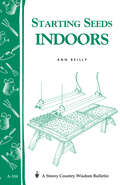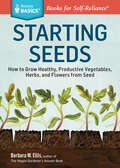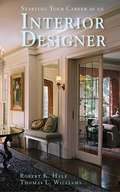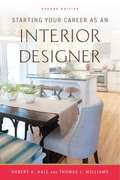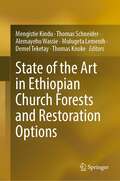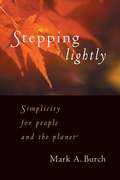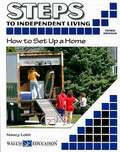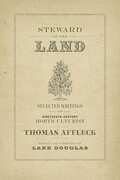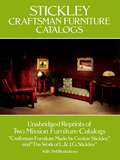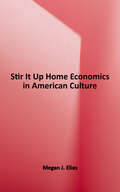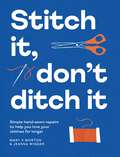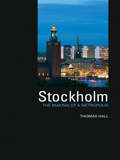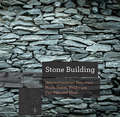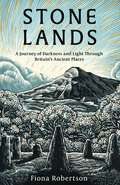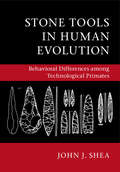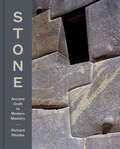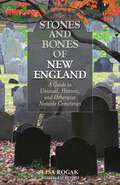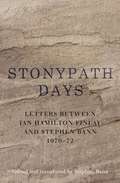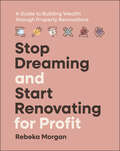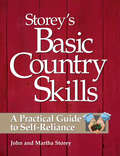- Table View
- List View
Starting & Running a Marijuana Business (Idiot's Guides)
by Debby GoldsberryThe most comprehensive and easy-to-understand guide to starting and running a marijuana business.Legal marijuana is one of the fastest growing industries on the planet, and aspiring entrepreneurs are chomping at the bit to get in on the "green rush". However, while starting any new business can be challenging, starting one in an emerging field with a new and changing legal landscape can be downright daunting. But whether your ambition is to start a grow facility or cannabis dispensary, Idiot's Guides: Starting & Running a Marijuana Business will help you navigate this complex industry with careful planning and special considerations to make the most of your new venture.In this comprehensive overview, you get:• Best practices for securing locations and permits, dealing with the financial restraints from the U.S. Government, and managing all of the day-to-day aspects of running a business.• Insights on the legal challenges from state-to-state and how to navigate them to maximize earning potential. • Expert advice on locating cultivation/dispensary sites, creating a business plan, securing finances, training staff, dealing with security measures, paying taxes, and offering medical patient counseling. • Marketing strategies to ensure the business grows and operates legally and effectively.• Checklists for any owner and manager to incorporate in their business and training to ensure all systems are covered.
Starting & Saving Seeds: Grow the Perfect Vegetables, Fruits, Herbs, and Flowers for Your Garden
by Julie Thompson-AdolfStep-by-step instructions for everything from selecting great seeds to creating your own seed-starting mix to harvesting seeds for next year’s garden.Creating dinner from food you’ve grown provides a fantastic sense of accomplishment. Now, imagine the pleasure of starting plants from seeds, tending them, planting them in your garden, harvesting their fruits, and enjoying a delicious meal or bouquet. But that’s not the end of the journey. Now you can turn around and save the best seeds for next year’s garden. Suddenly, you’re self-sufficient; you’ve grown your own garden from seed to seed.In this book, you’ll find the tools you need to become a seed starting and saving champion. Author and gardening expert Julie Thompson-Adolf walks you through every step of the journey, making the entire process a joy. You’ll find hints to encourage stubborn seeds to germinate, lists of varieties to add to your garden, charts for quick growing reference, and simple DIY projects to aid your seed starting and saving adventure. (Learn how to make seed bombs and an indoor seed-starting station.) The extensive plant entries inside cover all the most popular vegetables, fruits, herbs, and flowers. Get started with tomatoes, peppers, eggplants, and melons, or chamomile, cosmos, sweet peas, and poppies—accompanied by beautiful photography from Libby Williams.Whether you’re an experienced gardener new to seed starting and saving or a brand-new grower, you’ll soon have healthy, productive, beautiful plants for your garden.“Imagine a gardening expert who outlines all the steps needed to set up a seed-starting area in your home—and reassures you that ‘you’ve got this.’ Because with Julie’s help, you do.” —Frau Zinnie Blog
Starting Seeds Indoors: Storey's Country Wisdom Bulletin A-104
by Ann ReillySince 1973, Storey's Country Wisdom Bulletins have offered practical, hands-on instructions designed to help readers master dozens of country living skills quickly and easily. There are now more than 170 titles in this series, and their remarkable popularity reflects the common desire of country and city dwellers alike to cultivate personal independence in everyday life.
Starting Seeds: How to Grow Healthy, Productive Vegetables, Herbs, and Flowers from Seed. A Storey BASICS® Title (Storey Basics)
by Barbara W. EllisGet a jump on the gardening season! In this Storey BASICS® guide, Barbara Ellis provides the basic information that you need to start a variety of vegetables, herbs, and flowers from seed. Ellis shares simple, proven techniques for sowing seeds, managing indoor plants, and creating proper growing conditions so your seedlings can thrive. Packed with expert advice suitable for both beginners and experienced gardeners, Starting Seeds will inspire you to plant a seed and watch it grow.
Starting Your Career as an Interior Designer
by Robert K. Hale Thomas L. Williams<p><i>Starting Your Career as an Interior Designer</i> contains all the necessary tools and strategies to successfully launch and grow a professional design business in the competitive world of interior design. Drawing on the authors' extensive experience, this book includes case studies, and personal anecdotes that help teach you how to: <p> <li>choose a design field <li>obtain and keep clients <li>garner referrals <li>market and position your business <li>bid competitively on projects <li>manage sales <li>organize a budget <li>manage start-up costs and cash flow <li>promote your business <li>branch out into product and architectural design <li>design within a retail environment <li>set pricing guidelines <li>sell to your target demographic <li>set up your office </li> <p> <p>Readers will find a history of the business side of interior design as well as various career tracks available to today’s budding entrepreneur. Any early career interior designer or student looking for practical advice on the ins and outs of running a design firm will need this one-stop guide.</p>
Starting Your Career as an Interior Designer (Starting Your Career Ser.)
by Robert K. Hale Thomas L. WilliamsStarting Your Career as an Interior Designer contains all the necessary tools and strategies to successfully launch and grow a professional design business in the competitive world of interior design. Drawing on the authors' extensive experience, this book includes case studies, and personal anecdotes that help teach you how to: Choose a design field Obtain and keep clients Garner referrals Market and position your business Bid competitively on projects Manage sales Organize a budget Manage start-up costs and cash flow Promote your business Branch out into product and architectural design Design within a retail environment Set pricing guidelines Sell to your target demographic Set up your officeReaders will find a history of the business side of interior design as well as various career tracks available to today’s budding entrepreneur. This updated second edition also examines the current state of the interior design industry, and what's in store for the future of firms. Any early career interior designer or student looking for practical advice on the ins and outs of running a design firm will need this one-stop guide.Allworth Press, an imprint of Skyhorse Publishing, publishes a broad range of books on the visual and performing arts, with emphasis on the business of art. Our titles cover subjects such as graphic design, theater, branding, fine art, photography, interior design, writing, acting, film, how to start careers, business and legal forms, business practices, and more. While we don't aspire to publish a New York Times bestseller or a national bestseller, we are deeply committed to quality books that help creative professionals succeed and thrive. We often publish in areas overlooked by other publishers and welcome the author whose expertise can help our audience of readers.
State of the Art in Ethiopian Church Forests and Restoration Options
by Thomas Schneider Demel Teketay Mengistie Kindu Alemayehu Wassie Mulugeta Lemenih Thomas KnokeThis book, with contributions from leading academics - and including reviews and case studies from Ethiopian Church forests - provides a valuable reference for advanced students and researchers interested in forest and other natural resource management, ecology and ecosystem services as well as restoration options. The book addresses various aspects including a general overview of Ethiopian church forests, the present role and future challenges of church forests. It also discusses their structure and diversity in the context of sustainability and discusses restoration options for surrounding landscapes, under consideration of the circumstances of the land and the needs of surrounding communities. The intended readership includes natural resource professionals in general as well as forestry professionals in particular (practitioners, policymakers, educators and researchers). The book will provide the reader with a good foundation for understanding Ethiopian forest resources and restoration options of degraded landscape.
Stepping Lightly
by Mark A. BurchWhile the voluntary simplicity movement has grown by leaps and bounds in recent years, it is still often stereotyped as being mainly concerned with a thrifty lifestyle. But simple living has much deeper implications than just cleaning closets or selling off a second car. In Stepping Lightly, Mark Burch considers the deeper rewards of voluntary simplicity for individuals, and how the practice of simple living can be an essential part of the solution to our social and environmental problems. Thoughtful and eloquent, this book will appeal to a wide range of readers interested in committing themselves to stepping lightly into a more sustainable future.
Steps To Independent Living: How To Set Up A Home
by Nancy LobbCompletely updated, part of the best-selling series that shows students how to take care of themselves and face the challenges of everyday living. Explains essential tasks and responsibilities at a manageable reading level, with demonstrations, activities, illustrations, self-tests and comprehension checks throughout the text. How to Set Up a Home explains how to find an affordable place to live; how to choose a suitable roommate; and how to understand a lease, deal with utilities, and furnish an apartment .
Steward of the Land: Selected Writings of Nineteenth-Century Horticulturist Thomas Affleck (The Hill Collection: Holdings of the LSU Libraries)
by Lake Douglas Thomas AffleckIn the first collection of published writings of Thomas Affleck (1812--1868), Lake Douglas re-establishes the reputation of a tireless agricultural reformer, entrepreneur, and horticulturist. Affleck's wide range of interests -- animal husbandry, agriculture, scientific farming, ornamental horticulture, insects, and hydrology, among others -- should afford him a celebrated status in several disciplines; yet until now his immense contributions remained largely unheralded. Steward of the Land remedies this oversight with a broad, annotated selection of Affleck's works, rightfully placing him alongside his better-known contemporaries Andrew Jackson Downing and Frederick Law Olmsted.After immigrating to the United States from Scotland in 1832, Affleck witnessed the burgeoning American expansion and its major advances in agriculture and technology. He worked as a journalist for the influential Western Farmer and Gardener, covering Ohio, Kentucky, and the Mississippi River Valley. Affleck moved to Mississippi in 1842 to manage his new wife's failing plantation; there, he created one of the first commercial nurseries of the South while writing prolifically on numerous agrarian topics for regional periodicals and newspapers. From 1845 to 1865 he edited Affleck's Southern Rural Almanac and Plantation and Garden Calendar, published in New Orleans. Following a postwar move to Brenham, Texas, he published letters and essays about rebuilding that state's livestock herds and rejuvenating its agricultural labor forces.Steward of the Land includes excerpts from dozens of Affleck's articles on subjects ranging from bee keeping to gardening to orchard tending. This valuable single-volume resource reveals Affleck's astonishing breadth of horticultural knowledge and entrepreneurial sagacity, and his role in educating mid-nineteenth-century readers about agricultural products and practices, plant usage, and environmental stewardship. Never before collected or contextualized, Affleck's writings provide a firsthand account of the advancement of agricultural techniques and practices that created a new environmental awareness in America.
Stickley Craftsman Furniture Catalogs
by Gustav Stickley L. Stickley594 illustrations, including 277 photos, of authentic, prized, Craftsman furniture as shown in two catalogs -- circa 1910 -- by foremost manufacturers. Numerous settles, rockers, armchairs, bookcases, plus many other kinds of pieces. Captions.
Stir It Up: Home Economics in American Culture
by Megan J. EliasFor Americans who came of age in the mid-twentieth century, home economics conjures memories of burnt toast and sewing disasters. But as historian Megan Elias shows in Stir It Up, home economics began as an idealistic reform movement in higher education in the early 1900s. Leaders of this movement sought to discover and disseminate the best methods for performing domestic work while creating new professional options for women that were based on elements of home life. Home and family were treated as subjects for scientific analysis; students wore lab coats while baking bread and performed rigorous tests on the palatability of their work. The Federal Bureau of Home Economics supplied a grateful audience with informational bulletins as Americans seemed to accept the idea that home could be a site for social change. <p><p>A major shift occurred in the 1950s, when new ideas about women's roles seemed to divert home economics into more traditional channels, and "home ec" became identified with the era's conformist culture. Even as home economists were redefining family dynamics and influencing government policies, such as school lunch programs, their field was becoming an object of scorn, especially to the feminists of the 1960s. Stir It Up explains what the successes and failures of home economists can tell us about American culture. The book concludes with an examination of contemporary attitudes toward domesticity, putting the phenomena of Martha Stewart, Rachael Ray, Ty Pennington, and the "Mommy Wars" into historical context.
Stitch It, Don't Ditch It: Simple hand-sewn repairs to help you love your clothes for longer
by Mary V Morton Jeanna WiggerMastering the art of mending just requires a few simple sewing techniques which can extend the life of your wardrobe and your treasured clothing. Stitch it, Don’t Ditch It,will guide you through the fundamentals of mending, from the kit you’ll need, how to tackle different types of repair to the core skills covering the common mends that will help you fix 90% of your clothes. Aimed at those with limited or no sewing skills, this book provides step-by-step instructions and helpful tips, including how to thread a needle, replace a button, back stitch a torn seam, rescue ladders and snags in knitwear.Mary V Morton and Jeanna Wigger shows readers how to choose the appropriate technique for your repair, fabric terminology and the anatomy of garments, making this the ultimate guide to those who want to be less wasteful and more sustainable.Learn to darn socks, sew on patches, hem trousers, and stop fraying with this ultimate immersive guide to mending for anyone who wants to have a more sustainable style.
Stockholm: The Making of a Metropolis (Planning, History and Environment Series)
by Thomas HallThis is the first history of Stockholm’s development from the city’s unique seventeenth-century redevelopment and extension to the postmodern, postindustrial trends of today. While the city’s planners borrowed the ideas from abroad at certain periods, they provided the lead for the rest of the world at others. For much of the mid-twentieth century Stockholm was the model for Europe and elsewhere. Written by an acknowledged authority on the city and Swedish architecture and planning generally, with a wide range of illustrations, this book provides a much needed explanation of one of Europe’s great cities.
Stone Building: How To Make New England Style Walls And Other Structures The Old Way (Countryman Know How #0)
by Kevin GardnerA practical guide to simple stone building projects for your yard Nothing matches the look and feel of stone structures in and around your home. Yet most people are intimidated by the very thought of masonry, despite the obvious rewards. In Stone Building, Kevin Gardner distills his decades of experience building and maintaining iconic New England–style stone walls into this concise, informative guide. Gardner offers step-by-step instructions for building everything from flagstone walkways to classic patios and ornate fire pits. He also offers time-tested tips to help care for your stone, as well as repair and restoration advice for existing structures.
Stone Lands: A Journey of Darkness and Light Through Britain’s Ancient Places
by Fiona Robertson'Superb' Telegraph'There's a real sense of peace and magic in this beautiful book' Daisy Buchanan'Utterly endearing' Dr James Canton'A fantastic book for weird walkers and megalith-obsessives alike' Weird Walk 'I was alternately gripped and moved to tears by this brilliant, exquisite memoir. . . I can't recommend it enough' Harriet EvansJourneying across Britain, from West Penwith and Avebury to the Lake District and Orkney, Stone Lands uncovers the magic and rich history of our incredible prehistoric standing stones. It conveys the delight that lies in tracking them down, as well as the solace these ancient places offer in times of darkness.A few months after discovering that her beloved husband, Stephen, had incurable cancer, Fiona Robertson began to write this book. A long-time megalith enthusiast, she found the ancient stones resonated with her more profoundly than ever as she faced the prospect of losing him. Set upright thousands of years ago, the megaliths are symbols of endurance and survival, standing in contrast to our ephemeral human lives. Infused with folklore, legend and mystery, they enchant the landscape and bring magic to our modern world. This enthralling memoir is woven delicately around great grief but is ultimately about embracing life, joy and ancient wonder - a luminous reminder of what it means to exist on this earth.Stone Lands is beautifully illustrated inside with stunning black and white line drawings by the illustrator and printmaker Philip Harris. Find out more about his work: www.philipharrisillustration.com'A reminder that the ancient stones can be sources of reassurance and solidity, even in our times of greatest upheaval and loss' Angeline Morrison'A very, very good read ... this is one to treasure' Blackwell'sStone Lands is 'assiduously researched, full of anecdotes and makes you look anew at these enduring landmarks' Country Life
Stone Lands: A Journey of Darkness and Light Through Britain’s Ancient Places
by Fiona Robertson'Superb' Telegraph'There's a real sense of peace and magic in this beautiful book' Daisy Buchanan'Utterly endearing' Dr James Canton'A fantastic book for weird walkers and megalith-obsessives alike' Weird WalkJourneying across Britain, from West Penwith and Avebury to the Lake District and Orkney, Stone Lands uncovers the magic and rich history of our incredible prehistoric standing stones. It conveys the delight that lies in tracking them down, as well as the solace these ancient places offer in times of darkness.A few months after discovering that her beloved husband, Stephen, had incurable cancer, Fiona Robertson began to write this book. A long-time megalith enthusiast, she found the ancient stones resonated with her more profoundly than ever as she faced the prospect of losing him. Set upright thousands of years ago, the megaliths are symbols of endurance and survival, standing in contrast to our ephemeral human lives. Infused with folklore, legend and mystery, they enchant the landscape and bring magic to our modern world. This enthralling memoir is woven delicately around great grief but is ultimately about embracing life, joy and ancient wonder - a luminous reminder of what it means to exist on this earth.Stone Lands is beautifully illustrated inside with stunning black and white line drawings by the illustrator and printmaker Philip Harris. Find out more about his work: www.philipharrisillustration.com'A reminder that the ancient stones can be sources of reassurance and solidity, even in our times of greatest upheaval and loss' Angeline Morrison
Stone Lands: A Journey of Darkness and Light Through Britain’s Ancient Places
by Fiona Robertson'Superb' Telegraph'There's a real sense of peace and magic in this beautiful book' Daisy Buchanan'Utterly endearing' Dr James Canton'A fantastic book for weird walkers and megalith-obsessives alike' Weird WalkJourneying across Britain, from West Penwith and Avebury to the Lake District and Orkney, Stone Lands uncovers the magic and rich history of our incredible prehistoric standing stones. It conveys the delight that lies in tracking them down, as well as the solace these ancient places offer in times of darkness.A few months after discovering that her beloved husband, Stephen, had incurable cancer, Fiona Robertson began to write this book. A long-time megalith enthusiast, she found the ancient stones resonated with her more profoundly than ever as she faced the prospect of losing him. Set upright thousands of years ago, the megaliths are symbols of endurance and survival, standing in contrast to our ephemeral human lives. Infused with folklore, legend and mystery, they enchant the landscape and bring magic to our modern world. This enthralling memoir is woven delicately around great grief but is ultimately about embracing life, joy and ancient wonder - a luminous reminder of what it means to exist on this earth.Stone Lands is beautifully illustrated inside with stunning black and white line drawings by the illustrator and printmaker Philip Harris. Find out more about his work: www.philipharrisillustration.com'A reminder that the ancient stones can be sources of reassurance and solidity, even in our times of greatest upheaval and loss' Angeline Morrison
Stone Tools in Human Evolution
by John J. SheaIn Stone Tools in Human Evolution, John J. Shea argues that over the last three million years hominins' technological strategies shifted from occasional tool use, much like that seen among living non-human primates, to a uniquely human pattern of obligatory tool use. Examining how the lithic archaeological record changed over the course of human evolution, he compares tool use by living humans and non-human primates and predicts how the archaeological stone tool evidence should have changed as distinctively human behaviors evolved. Those behaviors include using cutting tools, logistical mobility (carrying things), language and symbolic artifacts, geographic dispersal and diaspora, and residential sedentism (living in the same place for prolonged periods). Shea then tests those predictions by analyzing the archaeological lithic record from 6,500 years ago to 3. 5 million years ago.
Stone: Ancient Craft to Modern Mastery
by Richard RhodesIn this perceptive and illustrative look at the expressive and practical use of stone throughout history, Richard Rhodes unlocks the underlying principles of this ancient material—and explains the closely guarded “Sacred Rules” of the Freemasons guild for the first time ever.The relationship between mankind and stone is elemental and deeply ingrained in us all. Stone, after all, has been the primary building material for more than five thousand years of human history, and it continues to record our triumphs and failures. In this searching history, Rhodes—a sculptor, stonemason, and scholar of stonework—explores how stone is best used today and throughout history. Stone presents the closely kept “Sacred Rules” developed over centuries by the medieval Freemason guild, previously available only to the initiated. Here, the rules are explained through historical examples and photographs. In these times of rapid development and expansive urbanization, Rhodes implores us to explore the essential qualities of stone that emerge from the Sacred Rules, not only to rediscover the ancient and traditional knowledge that governed its use for so long but also to find a roadmap for how future generations might thoughtfully recapture the power this material offers.MOST RENOWNED STONEMASON IN THE U.S.: Richard Rhodes apprenticed as a stonemason in Siena, Italy, after graduate studies at the London Academy of Music and Dramatic Art. As the first non-Italian admitted into Siena’s ancient masonic guild in 726 years, he is known throughout the sculpture and stone community as the “last apprentice.” HISTORICAL EDUCATION: A nationally acclaimed lecturer and educator, Rhodes has shared his deep knowledge of the history of stone and stonemasonry through convention addresses to the American Institute of Architects and the Association of Professional Landscape Designers, a five-lecture educational series to the Institute of Classical Architecture in both New York and San Francisco, and lectures to the Building Stone Institute and many public and private universities. His work has been featured in Architectural Digest, New York Times, Architectural Record, MSNBC, The Globe and Mail, Greenwich Post, Seattle Times, and The Globe and Mail, among many others. EXPERT CONTRIBUTOR: The book includes a foreword by Paul Goldberger, a contributing editor at Vanity Fair and previous architecture critic for both the New Yorker and the New York Times, where he was awarded the Pulitzer Prize. He is the author of many books, including Why Architecture Matters.
Stones and Bones of New England: A Guide To Unusual, Historic, and Otherwise Notable Cemeteries
by Lisa RogakWhether it's for their solace and beauty or for the sense of history that seeps from the ground, cemeteries are fascinating places to visit, this guide shows where to find the most interesting and unusual ones in all of New England. Some have headstones that are fine art, others are associated with notorious events, and others are the final resting place of famous poets, soldiers, and statesmen. Included are large public facilities as well as the small family burying grounds hidden away behind crumbling stone walls and along once-cultivated farmland. A sampling of cemeteries profiled:*Hope Cemetery in Barre, Vermont, where lifelike sculptures of angels and Greek goddesses stand next to a stone soccer ball and Shell Oil truck gravemarker, all elaborately carved from local granite by immigrant Italian stonecutters. *Spider Gates Cemetery, in Leicester, Massachusetts, a notorious Quaker burying ground famed for its frequent ghost sightings and still in use today.*A cemetery situated on the raised median of the Interstate in Warner, New Hampshire,which was preserved in 1970 by highway planners, who constructed the roadway around it.*Evergreen Cemetery in New Haven, Vermont, final resting place of Timothy Clark Smith, whose 1893 crypt includes a window to help him escape in case he was buried alive.Driving directions are provided for each cemetery, and detailed maps show the location of the more obscure graveyards. This unique guide offers an intriguing way to learn about the history and culture of New England.
Stonypath Days: Letters between Ian Hamilton Finlay and Stephen Bann 1970-72
by Stephen Bann Ian Hamilton FinlayThese letters to (and from) Finlay's friend, the English poet and scholar, Stephen Bann, centre on the initial development of the garden at Stonypath, near Edinburgh, later to become the world renowned 'Little Sparta'. They cover Finlay's turn away from poetry towards sculpture and garden design, and the thinking behind, and consequences of, this development.
Stop Dreaming and Start Renovating for Profit: A Guide to Building Wealth through Property Renovations
by Rebeka MorganTurn your passion for renovating and home design into profit Do you love the idea of renovating and flipping houses, but you’re scared to take the plunge? Stop Dreaming and Start Renovating for Profit is an inspiring, practical how-to guide for creating financial independence by renovating and reselling residential properties. Registered builder and successful developer Rebeka Morgan has helped thousands of women buy, renovate and sell properties for profit. In this book, she shares her tried-and-tested advice for harnessing your unique strengths to strategically improve a property’s value — and build your wealth quickly. You’ll grow your skills as a planner, decision maker and developer, learning how to be creative and find the gains that add up to thousands of dollars in profit. And you’ll discover how renovating can be a flexible, profitable business that fits into your busy life. Whether you’re caring for your family, rethinking your career or simply looking to boost your income, this book will empower you to take action and grow your earnings. Inside, you’ll find: Practical tools and case studies to help you see the big picture, find your vision and seize the courage to get started Strategies for analysing feasibility and designing profitable projects Hands-on, step-by-step guidance for managing the design and build process Advice that will help you avoid time-consuming and costly mistakes Tips for marketing and selling your property once the renovations are done Renovating property is not a guaranteed shortcut to quick profits. Getting a return on your investment is about seeing a home’s potential and then taking smart steps to realise that potential. Whether you’re just getting started or you’re looking to build a business flipping homes, Stop Dreaming and Start Renovating for Profit is a can’t-miss resource.
Store It!
by Mervyn KaufmanSTORE IT is the comprehensive guide to making, finding and organizing space in your home from the entryway to the attic.
Storey's Basic Country Skills: A Practical Guide to Self-Reliance
by John Storey Martha StoreyWhether you live on a small suburban lot or have a many acres in the country, this inspiring collection will empower you to increase your self-sufficiently and embrace a more independent lifestyle. A variety of authors share their specialized knowledge and provide practical instructions for basic country skills like preserving vegetables, developing water systems, keeping farm animals, and renovating barns. From sharpening an axe to baking your own bread, you&’ll be amazed at the many ways learning traditional skills can enrich your life.


